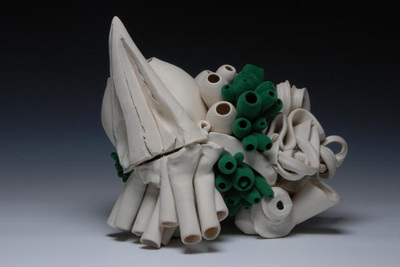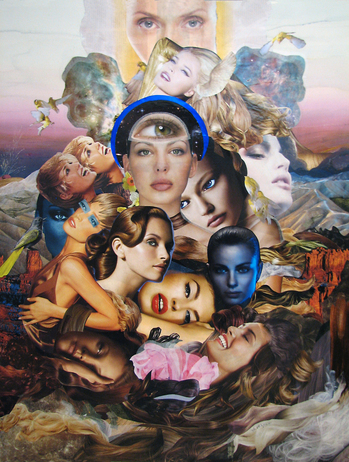Clay Gallery assembles a challenging 2-person exhibit

“1287 in 3” by Monica Wilson
It’s one of those two-artist exhibits in which the halves may not initially seem to be related—but they are. Study these artist’s definition of assemblage, and you'll see what Wilson and Miljour have in mind.
Assemblage is typically a rather peculiar form of art: three-dimensional works pulled together from found or disparate objects. Yet this definition doesn’t seem to initially fit this display particularly well.
In fact, the Ann Arbor Art Center’s current “Everything and the Kitchen Sink” exhibit is closer to this conventional definition.
So what do Miljour and Wilson have in mind?
“Monica and I met numerous times to discuss different approaches to this project,” says Miljour in her statement about the show, “and we eventually went our own way.”
“Working with Bonnie on this project,” replies Wilson in her gallery statement, “has pushed me in a direction I don’t think I would have discovered otherwise. I spent much of the first year creating a collection of thrown shapes to later combine into small assemblages. I kept prints of Bonnie’s collages in my work space, letting the imagery influence some of the shapes I was making.”
“This time,” replies Miljour, “I decided to try collage, mainly because I was unfamiliar with it. Each picture took a long time to make, some were remade many times.
“I noticed as I worked that landscape imagery was assuming a background importance,” continues Miljour, “while what emerged to dominate the foreground, in each instance, and was human and female. I tried to deliberately change the focus but I had trouble until I returned to those fragments of women’s faces and I was especially interested in the eyes.”
Which leads Wilson to say: “My work is influenced by the constant push-pull between the organic and the mechanical, variation in physical and psychological weight, and the process of working with a malleable surface and firing it to a dense unyielding stone.”
So this is art that’s certainly disparate—but unified. What are we to make of these two types of art that aren’t at all alike, yet pulling from each other dialectically?
The notion of three dimensions fits, although, like most painting and drawing, Miljour’s third dimension is rather thin. Rather, as stated above, the answer lies in studying the surface features of these artworks, because it’s at these levels vague commonalities begin to yield aesthetic similarities.
Take the nature of Wilson’s 23 ceramics in the exhibit: They have little overt similarities with the visual cues of Miljour’s collage. Yet the key to this collage lies in the disciplined manner with which it has been pieced together, and this very same discipline lies at the heart of Wilson’s biomorphism.
The bundled intensity of Wilson’s “Transplants”—a hedge of miniature quasi-vegetative spears rising up together in a spiky cluster—is one of a collective dynamic. Individually, they are a simple and rough-hewn triangular motif; yet taken together, they are a repetitive design that suggests a grove or natural ridge.
Likewise, Wilson’s “Urban Crawl” looks like grapes (or some kind of worm?) clustered in the corner of its base. In both instances, the finished texture of the ceramic—rough in the case of “Transplants” and smooth in the case “Urban Crawl”—gives the work a sense of vigor.
The Wilson work that seemingly has been most influenced by the two artists' give-and-take is “1287 in 3.” This patched ceramic certainly partakes of the notion of assemblage with discernably differing clay elements fused together in one object. Some of these parts are winding tendrils, while other attached forms have a jagged resemblance to “Transplants.” This is most certainly a conceptual and material assemblage as crafted through ceramic art.
By contrast, the borders of Millie Miljour’s 20 collages clearly define her definition of assemblage. Consisting of hundreds of scraps of paper, netting, and foil on archival board, her largely photo-based artworks are so sharp-edged, it takes a bit of effort to study the outlines she’s crafted.

“Eyes of Ecstasy” by Bonnie Miljour
Using a color scheme and construction that’s vaguely reminiscent of pan-Asian art, Miljour stacks these models until one faces the viewer with an oversized eye of Horus in the center of her forehead surrounded by a twinkling cosmic crown.
These are “Eyes of Ecstasy,” indeed. And like the rest of Miljour’s and Wilson’s work, this photo collage shows us that what we take out of “Assemblage” has to be traced from the periphery to the depths of our imagination. We need only assemble the exhibit piece by piece.
“Assemblages: Bonnie Miljour and Monica Wilson, a Collaboration” will continue through Aug. 28 at The Clay Gallery, 335 S. Main St. Gallery hours are 11 a.m. to 8 p.m., Monday-Thursday; 11 a.m. to 9 p.m., Friday-Saturday; and noon to 5 p.m., Sunday. For information, call 734-662-7927.

